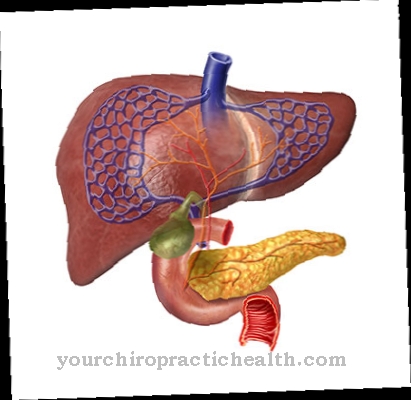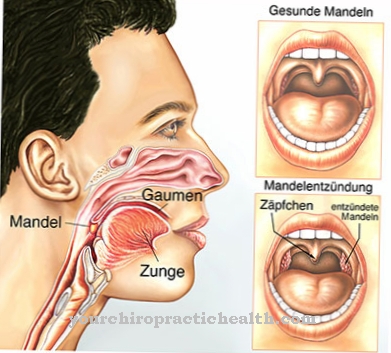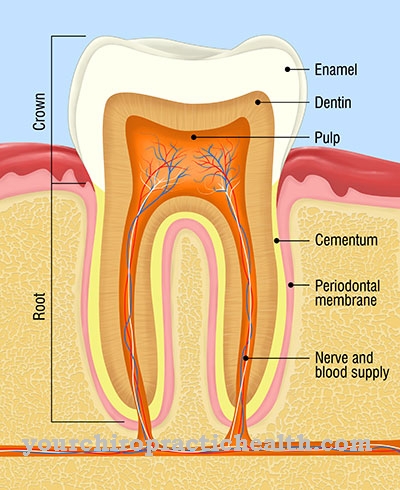A cold or gripal infect are a common respiratory infection. It is caused by viruses and is mostly acute. Typical signs of a cold are hoarseness, sore throat and runny nose.
What is a cold?

A cold or flu-like infection is caused by viruses. This causes an infection of the upper respiratory tract (nose, throat, bronchi). As a rule, the cold viruses can be easily transmitted by droplet infection. It is not uncommon for a cold to lead to so-called secondary infections with bacteria. Depending on the extent of the secondary infection, treatment with antibiotics is indicated.
A cold, also known as a flu-like infection, should not be confused with the flu (influenza), which is usually much more severe. A common cold lasts between one and two weeks. Adults get a flu-like infection around two to four times a year, while children are much more likely to develop it, sometimes up to twelve times a year.
causes
There are a total of more than 100 different cold viruses that can be transmitted by coughing or sneezing and lead to a cold. The time from infection to the onset of the disease, also known as the incubation period, is two to five days.
First, the viruses attack the lining of the nose and throat. From there, they can spread to the bronchi and sinuses.
If the immune system is weakened or the mucous membrane is not intact, it is much easier for viruses and the body to become ill more quickly. To avoid infection, you should wash your hands each time you blow your nose, because the cold viruses can survive on the surface of the skin for several hours.
Symptoms, ailments & signs
With a cold or a flu-like infection, typical symptoms occur. These first show up on the neck. It is typical for the onset of a cold that the affected people suffer from unpleasant sore throat, which in the further course spreads to a sore throat and difficulty swallowing.
A short time later, symptoms such as tingling, itching or burning appear on the nose. In addition, an increased urge to sneeze can be felt and a thin liquid secretion constantly flows out of the nose, which doctors call runny nose. The runny nose is one of the most common signs of the common cold. It occurs in around 80 percent of all patients.
The runny nose results from inflammation of the nasal mucous membrane, which swells and produces watery secretions. In the further course of the flu-like infection, the secretion takes on a more viscous consistency (stick runny nose) and has a yellow-green discoloration.
In addition, the patient can no longer breathe properly through the nose and feels that it is blocked. The typical cold symptoms also include the cough, which is tough and dry in the early stages. Later it shows up more mucous and can be coughed up. If the cold viruses spread to the bronchial mucous membranes, bronchitis occurs, during which the cough is painful.
Other cold symptoms include chills, hoarseness, and headache and body aches. In addition, an increased temperature, tiredness and a general feeling of illness may occur.
course
A cold usually starts with a runny nose and sneezing. Nasal breathing is impaired by the swollen mucous membranes. With a bacterial infection, the nasal secretions turn greenish yellow over time. When the sinuses close up, there can be uncomfortable pressure on the ears. Other symptoms are tiredness and fatigue, a slight fever, cough, headache, body aches and a sore throat. After about a week, the symptoms of the common cold slowly start to subside.
Complications
With a cold, there are usually no particular complications. In most cases, everyone has a cold several times a year and can fight it without the aid of medication.During the cold, the body's immune system is weakened and everyday life is restricted. There is pain in the extremities.
There is also pain in the head and ears. It is usually no longer possible to perform physical activities or exercise. The patient feels tired and weakened and can no longer actively participate in life. Complications can arise when the common cold causes inflammation in the ear or lungs.
Treatment with antibiotics is necessary here. There are no further complications with the treatment if it is started early. In most cases the common cold disappears on its own after a few days.
The common cold also affects the voice and throat. Talking and swallowing is usually painful. The difficulty in swallowing can cause temporary dehydration and weight loss.
When should you go to the doctor?
A harmless cold is not necessarily a reason to see a doctor unless a doctor's certificate is required for the employer. However, some people do not see a doctor even if their symptoms are worse. In certain cases, however, a doctor should always be consulted:
- Difficulty breathing can be a symptom of pneumonia that must be treated by a doctor.
- Fever in infants or a high fever in adults may indicate a bacterial infection that may May require treatment with antibiotics.
- Severe throat or ear discomfort can be related to a purulent tonsillitis or otitis media.
- Severe pain should always be clarified by a doctor.
- Fatigue and fatigue can be symptoms of the flu.
In general, a doctor should always be consulted if the cold symptoms have not improved after approx. 7 days, if yellowish-green sputum is present (it can indicate a bacterial infection), persistent pain in the head, neck or chest or with swollen lymph nodes. Risk groups such as asthmatics, people with an immune deficiency, pregnant women, people with cardiovascular diseases or chronic diseases and people who return sick from vacation should always consult a doctor as a precaution.
Doctors & therapists in your area
Treatment & Therapy
A visit to a doctor is usually not necessary for a normal cold. However, the patient should take it easy, get enough sleep and drink a lot. Hot drinks are particularly beneficial when you have a cold. Inhalation with special essential oils or with salt water can significantly improve the symptoms. Most patients also find a cold bath to be very pleasant.
If you have a stuffy nose, you can use nasal spray with a decongestant effect. However, this spray should not be used for more than 10 days, as it has a drying effect and the nasal mucous membranes get used to it quickly. Seawater spray is therefore particularly suitable for moistening the nose. Furthermore, care should be taken to keep the head high when sleeping so that breathing is easier. Cigarettes and alcohol should be avoided completely if you have a cold, as they also weaken the immune system.
Used paper tissues should be thrown away immediately after use and hands should be washed with soap several times a day to avoid self-infection. In terms of nutrition, attention should be paid to a diet rich in vitamins. It is also useful to take vitamin C supplements as a dietary supplement.
Physical exertion and sport should be avoided entirely during a cold, otherwise you risk heart muscle inflammation. Premature stress can quickly lead to a relapse, so it is essential to ensure that the cold is cured sufficiently.
↳ More information: Home remedies for a cold
Outlook & forecast
A cold usually gets better on its own within a few days to weeks without the need for medical help. Depending on where the bacteria or viruses are located, typical symptoms such as runny nose, sore throat, hoarseness, cough, headache, low fever, fatigue and loss of appetite occur. All symptoms can appear at the same time or one after the other.
More severe courses are possible in children and the elderly as well as in patients with a weakened immune system. Symptoms can be worse and more uncomfortable, and the common cold can last longer. Of course, depending on the pathogen, this is also possible in otherwise healthy adults. There is then the possibility of treatment with antibiotics, provided that the pathogen is bacteria.
In principle, there is a risk of spreading with every cold, so the pathogen can also attack deeper organs. The best known is certainly pneumonia, which can result from a cold, for example if the patient does not take enough care of himself.
If the immune system is severely damaged, for example with diseases such as HIV / AIDS or therapy with immunosuppressants, even a harmless cold can become fatal, because the human immune system is the best defense against a cold. If it no longer works, the pathogens can spread unhindered in the body - with all the associated complications.
Aftercare
A cold can occur in many different degrees of severity, so appropriate follow-up care depends on many different factors. While the affected person has a cold, measures can be taken that can lead to significant improvement. This includes, for example, a visit to the family doctor or the use of appropriate medication.
After a cold has been overcome, follow-up care should still be carried out so that the symptoms do not flare up again. The body should not be driven to peak performance immediately, because the entire immune system is still considerably weakened after a cold. It is advisable to avoid heavy work and activities as there is not enough strength to do it.
Taking additional vitamins can be beneficial in this context. Which vitamins should be taken can be discussed with your own family doctor. Follow-up care is not absolutely necessary if you have overcome a cold. However, some measures can contribute to a faster recovery, so that aftercare should not be missed.
A visit to the doctor can help in this context, because a cold always occurs individually and in different degrees of severity. In any case, follow-up care does not have a negative effect, but rather contributes to a stronger immune system.
You can do that yourself
A flu-like infection is caused by viruses and can develop very differently depending on the specific pathogen and the patient's constitution. Mild forms of the common cold can also be treated yourself. For the most common symptoms - cough, runny nose and sore throat - pharmacies offer various over-the-counter drugs. It usually helps if the patient spares himself for two to three days and stays in bed.
If the cold does not get better after a few days or if symptoms such as high fever or shortness of breath appear, it is imperative that professional medical help is sought promptly. After consulting your doctor, individual symptoms of the common cold can also be treated with mild home remedies. Nasal rinsing with warm salt water helps against colds and an inflamed throat.
Special nasal showers and suitable salts are available from specialist retailers and drugstores. The procedure requires practice and is not necessarily aesthetic, but very effective. Steam baths with salt water or chamomile tea are easier to use. Gargle with sage tea also helps with severe sore throats. If you have a high fever, cold leg compresses provide relief.
The patient can also promote recovery through plenty of rest, a light diet rich in vitamins and by avoiding excessive alcohol and cigarettes.


.jpg)
.jpg)























